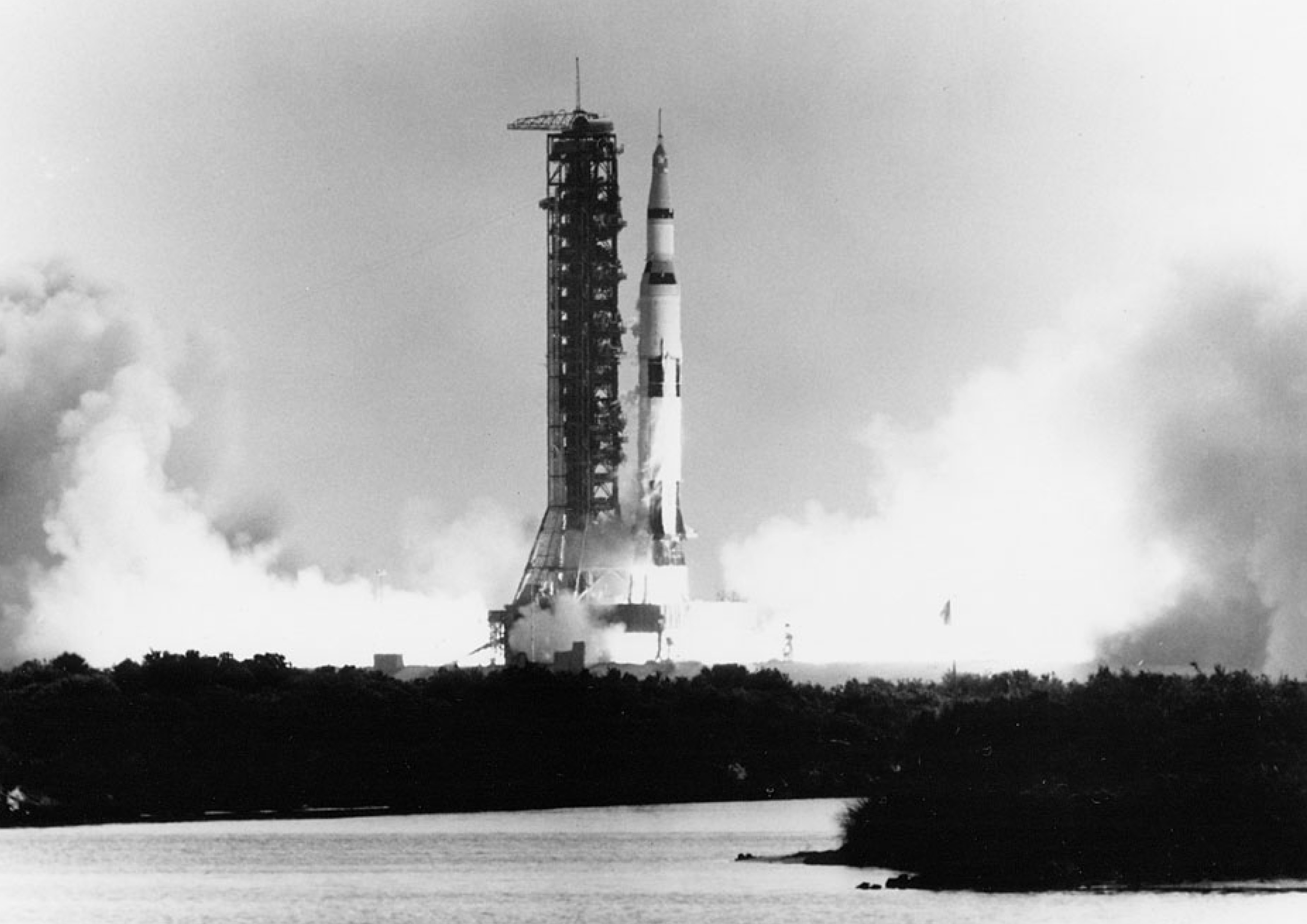
space rocket - way to the moon
Deutsch
Moon landing
"I believe that this nation should commit itself to achieving the goal, before this decade is out, of landing a man on the moon and returning him safely to the Earth."John F. Kennedy 25. Mai 1961
President Kennedy's speech launched NASA's Apollo program. Today, the world's population still remembers the Apollo 11 mission, which landed humans on the moon for the first time in a Saturn V. Behind the Apollo Saturn missions were about 20,000 companies and over 300,000 people. The road to this success was accompanied by a series of failures in the testing and development of rocket technology. After a tragic accident on the Apollo 204 mission, later renamed NASA's first Apollo mission, in which three astronauts died during a ground test on the Cape Kennedy launch pad due to a fire started with pure oxygen in the command module of a Saturn-IB SA-204, the U.S. did not launch the first manned space mission until 1968 with Apollo 7 in a Saturn-IB SA-205.
"The first steps on the moon were a piece of cake.
But getting to the moon was anything but easy"
Buzz Aldrin - 20.06.1969
Beyond the earth
The work "space rocket - way to the moon" deals with the research question of how technically abstract and complex content, can be made accessible with the help of targeted group-specific design principles through interpretive, visual forms of translation of information.
The question is how these goals can be optimally achieved with the different means of information design, when the requirements for infographics are efficiency, accessibility, reproducibility, goal orientation and enlightenment.
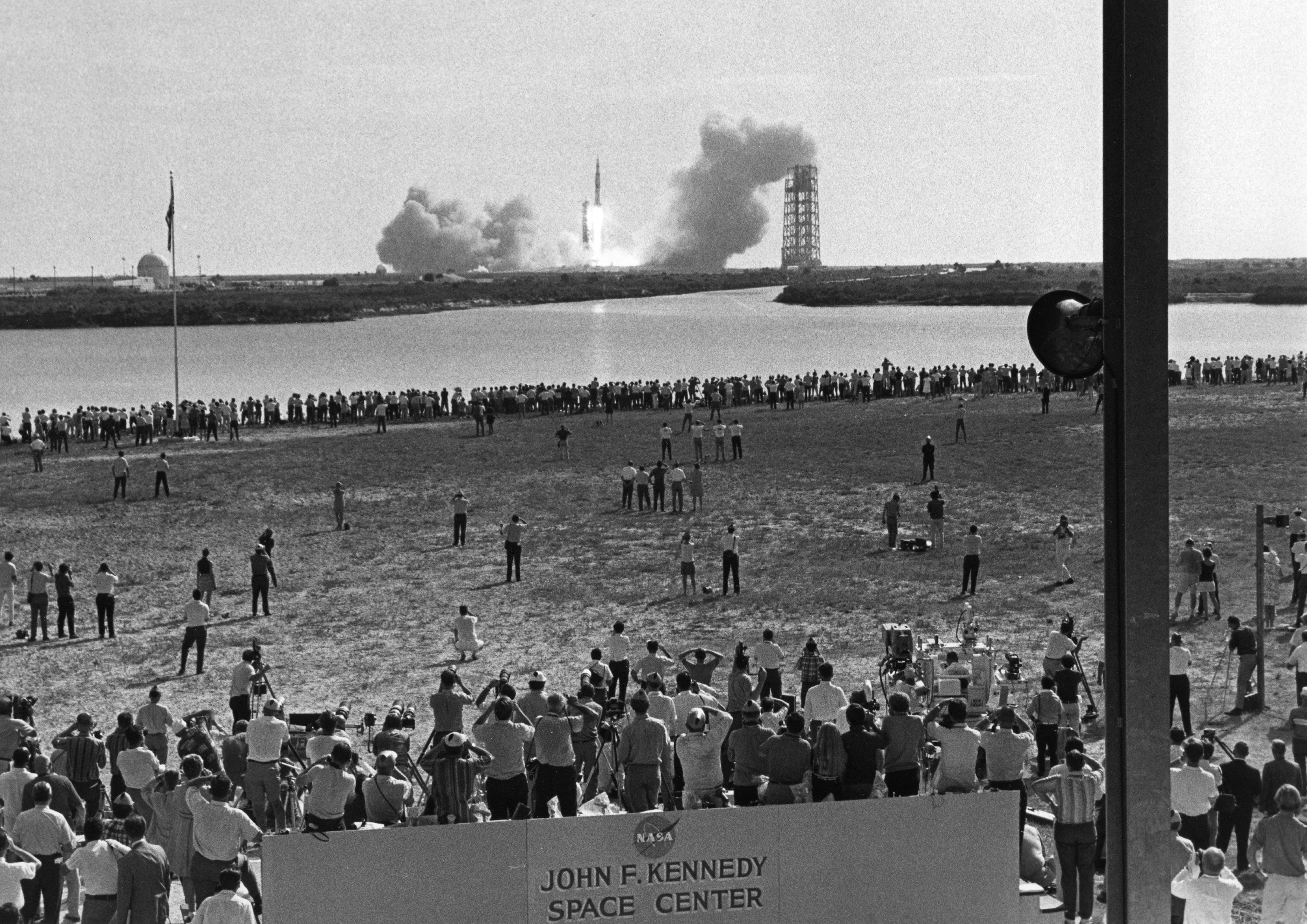
Through the visual knowledge transfer in the work, characterized by different images, videos, graphics and a haptic 3D model, an easier link unfolds between the visual means and the technical complexity for the viewer. In the iterative design process, the idea and interest in space travel initially stood in the room and quickly developed into a complex field of information via research methods, new perspectives and a media playout.
Saturn - I
Previously developed by NASA under the direction of Wernher von Braun and tested in unmanned flights, the Saturn-I type, formerly Juno V, consisted of two stages, the first stage (S-I) being powered by eight H-1 engines using kerosene (Rocket Propellant RP-1) as the combustion carrier and liquid oxygen as the oxidizer. The respective engines were similar to the military Redstone engines, the combustion chambers were connected to the kerosene and oxygen tanks by pumps and were capable of generating almost 900kN thrust with a burn time of about 150 seconds.
The rocket's course correction could be performed by four thrusters pivoting a few degrees about the pitch and yaw axes. Problems in the development of the H-1 engines occurred due to unstable combustion of the fuel mixture during ground tests, cracks in the liquid oxygen pumps due to excessive stresses in the aluminum alloy, or bursting of tubes and the walls of the thrust chambers due to a reaction of the nickel alloy inside with the fuel. The second stage (S-IV) consisted of six RL-10 engines fueled by the two cryogenic gases oxygen and hydrogen. This LH2/LOX combination presented NASA engineers with the technical challenges of a high cooling temperature and insulation for both tanks at the start of the new development, since hydrogen is classified as highly cryogenic, had a low mass and the gases were in a liquid state. The LH2/LOX combination allowed a nearly 40% increase in thrust over previous models without hydrogen, a 66.7kN thrust in vacuum, a burn time of circa 480 seconds, and a 77kN thrust at launch. Decades later, this research served the development of other launch vehicle systems worldwide, such as ESA's Ariane 5 and the US Space Shuttle.
Saturn - IB
The Saturn-IB rocket, which was successfully used for Apollo 5 and Apollo 7, was based on the Saturn I rocket. The first stage (S-1B) of the Saturn IB was powered by eight improved H-1 engines, which provided higher thrust and thus enabled a greater payload. The eight engines, with RP-1 oxygen and kerosene tanks, were arranged octagonally around the central combustion tank, as on Saturn-I, and were largely identical in design. The second stage (S-IVB), unlike the six RL-10 engines of the Saturn-I's S-IV stage, was single-engine with a J-2 engine. The different goals of the missions, such as ignition of the engine in a vacuum, were distinguished by individual configurations on the engine and in the payload. Separate ignition of the engines in vacuum and in Earth orbit could be ensured by an adjustable mixing ratio in the J-2 engine of oxygen and hydrogen via a pneumatic valve system. In addition to the J-2 engine, flight control systems with attitude sensors, hydraulic-electric and motor-driven pumps, actuators that convert electrical signals into mechanical impulses, and auxiliary propulsion systems that provided coordination in space were installed. The respective electrical systems, as well as telemetry, environmental, ordnance, and radio systems, were located in the instrumentation unit above the S-IVB stage and were monitored by a higher-level system complex of sensors.
Saturn - V
To this end, the work "space rocket - way to the moon" is based on an examination of the Saturn V moon rocket, which landed the first humans on the moon during NASA's Apollo 11 mission in 1969.The lunar landing on July 20, 1969, by a NASA Saturn V was an event in space technology that represented the Saturn family's large payload and performance capabilities and allowed the U.S. to reach the preeminent milestone in the race to space. Worldwide, the first landing of astronauts Neil Armstrong, Edwin "Buzz" Aldrin and Michael Collins was shown in television broadcasts, some 600 million people watched the first steps of two humans on the lunar surface and the global, political turmoil, disasters and Vietnam conflict moved out of focus for a short time. In addition to the Apollo 11 mission, the Saturn V was successfully used on missions 4, 6 and 8 through 17.1 The 111-meter-high heavy lift rocket was NASA's most powerful rocket to date, far surpassing the Saturn-I and Saturn-IB rockets in payload and performance.2 Unlike its two-stage predecessors, Saturn V incorporated a third stage and a new engine system. Wernher von Braun and his team at Marshall Space Flight Center in Huntsville, Alabama, again took the lead in building the largest model in the Saturn family. The Saturn V was a three-stage rocket designed to carry people and cargo into space. The rocket consisted of three main parts: the S-IC (first stage), the S-II (second stage) and the S-IVB (third stage). The first stage was equipped with five F-1 engines capable of generating a total of 7.5 million pounds of thrust. These engines were the most powerful rocket engines ever built and enabled the rocket to overcome Earth's gravity and reach space. The second stage used five J-2 engines that used liquid hydrogen and liquid oxygen as propellants. These engines provided a total of 1 million pounds of thrust and helped the rocket increase speed and reach Earth orbit. The third stage, the S-IVB, used a J-2 engine and was capable of delivering the payload to the desired orbit.
Side Fact: The Saturn V rocket was so large that it had to be manufactured at the Michoud, Louisiana, factory because it would not fit in a normal factory. The building was 363 meters long and 135 meters wide.
Currently and in the near future, NASA, ESA and private space companies like SpaceX are initiating the next steps of space exploration towards "leaving Earth" and "permanently colonizing the Moon and Mars". This process needs many of the aspects addressed above to be accepted and supported by society.
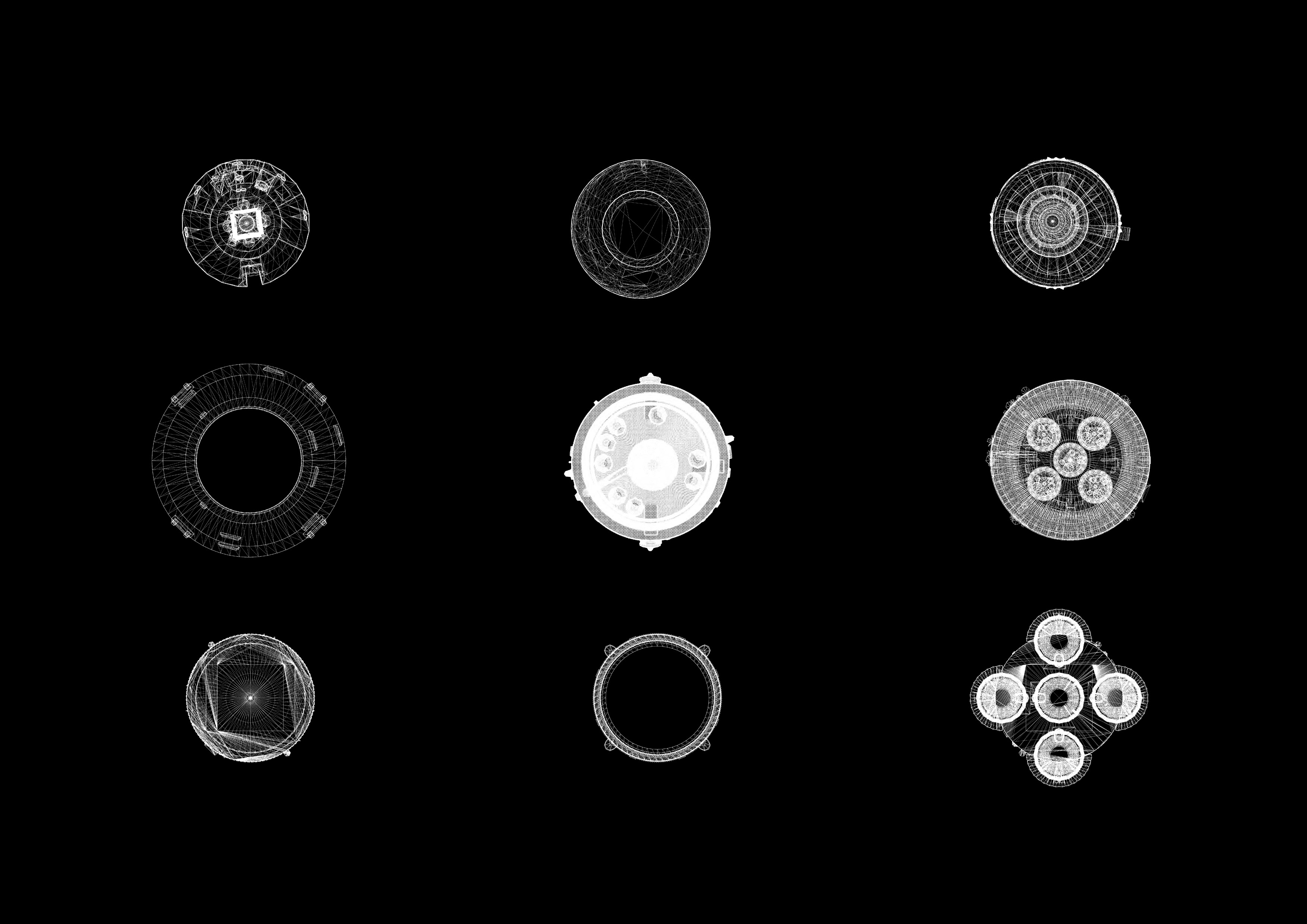
Saturn V - Webbased
Space rockets provides a web-based interactive information interface with videos, illustrations, a contextual embedding and exploded views of the object visually prepared information. The design is based on a prototype mockup using the Figma prototyping tool.Screencast
Website User Interface
The website shows a 3D model of the Saturn V rocket in the center, which rotates 360° as an individual explosion view. To the left of it, the respective top views of the individual parts are shown and the 3D model in an isometric view. On the right side data, facts, names and important information are shown.
.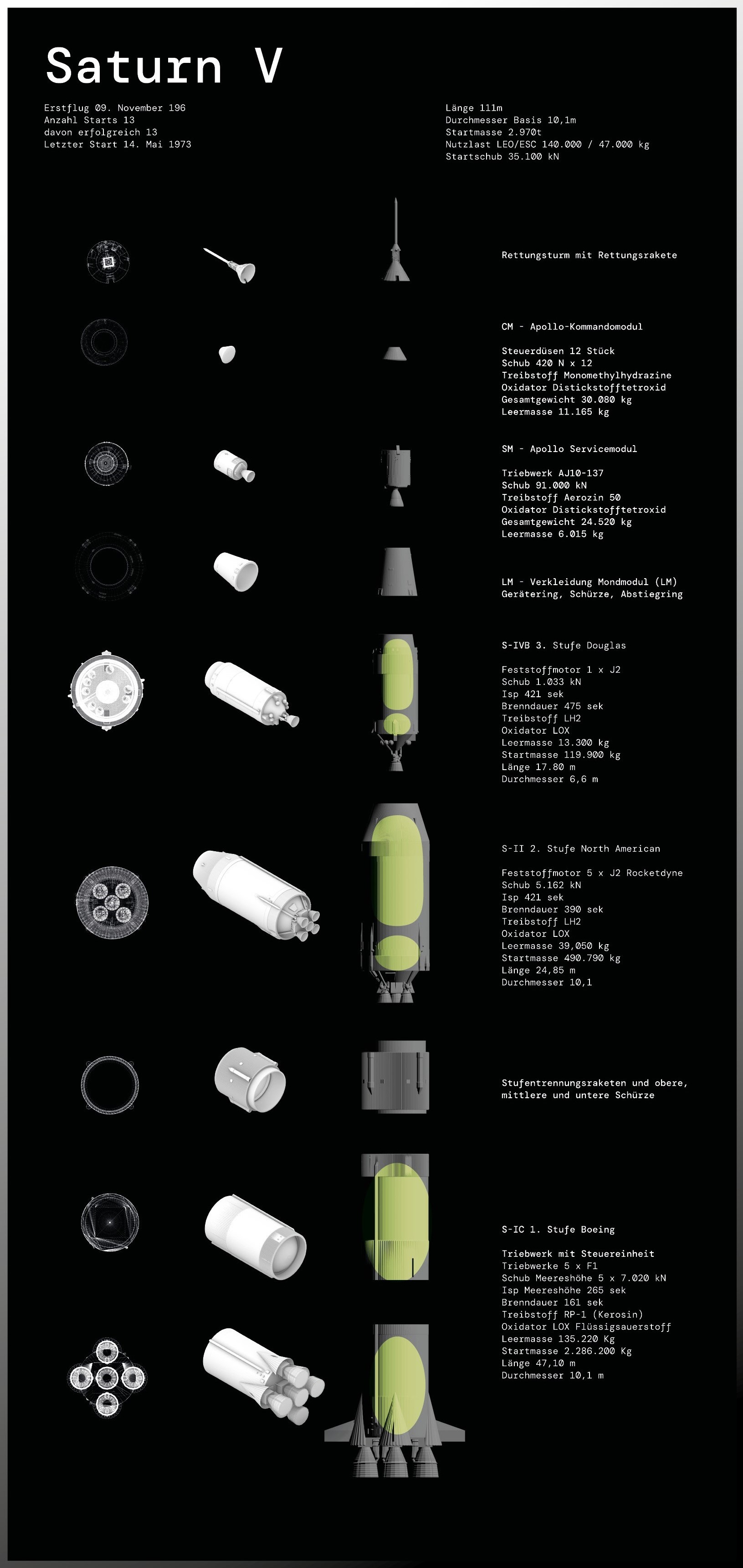
Website Interaction
Between the first state of the videos and the unfolded, visible state of the elements, a hover, also called mouseover effect is integrated. This allows the user to change and discover the website by interacting with the computer mouse and linking.
.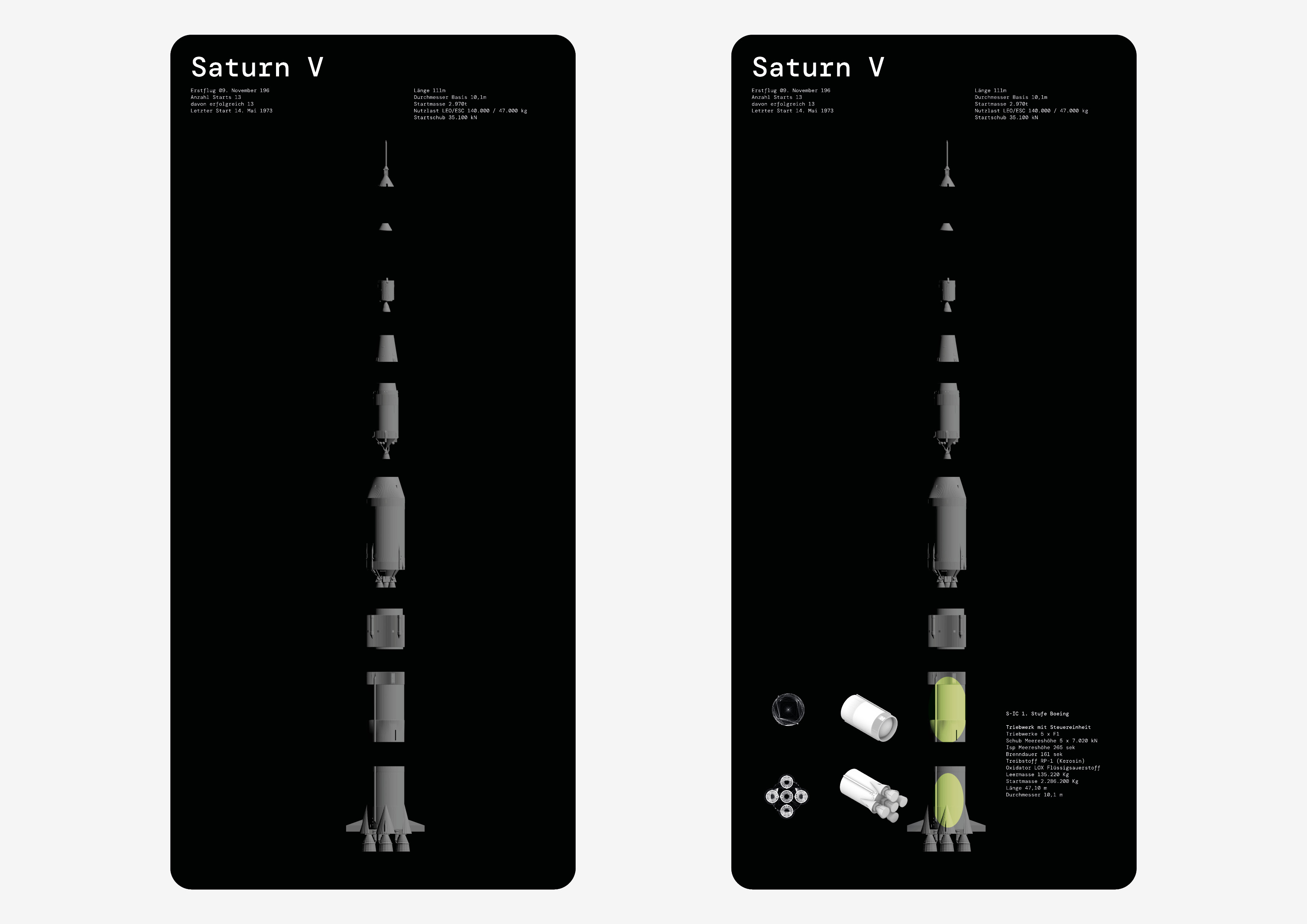
Saturn V - Print
Information poster Kommando und Servicesmodul (CSM)
The high flight speed and required precision in flight, makes the coordination via a fully automatic control system essential. At the same time, the on-board computer, designed by the IBM company, held only 2.4MB of code memory during the 1969 moon landing, could execute 11,300 commands per second and had a total capacity of 917,504 bits.

Saturn V - Model Making
3D model and 3D printing
The work includes as well the exhibition of the real object as a 3D printed Saturn V model rocket in scale 1:100.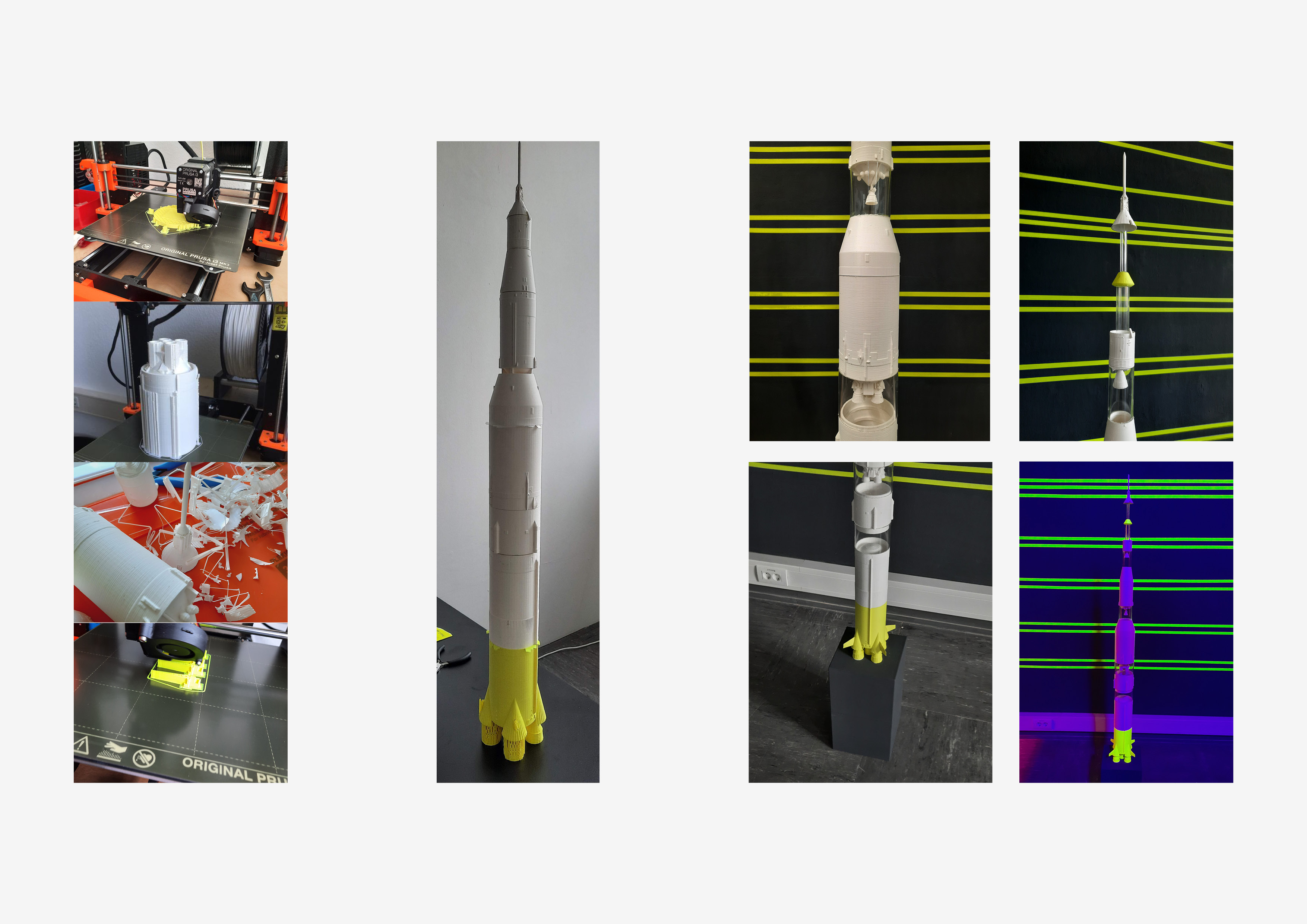
Saturn V - F1 engine graphic
Line graphic made from tape
The presentation is enhanced by a 1:1 scale line illustration of a lower F-1 engine of the Saturn V stage IC mounted on a wall. It is this illustration that allows viewers to experience the dimensions for themselves by stepping inside the installation.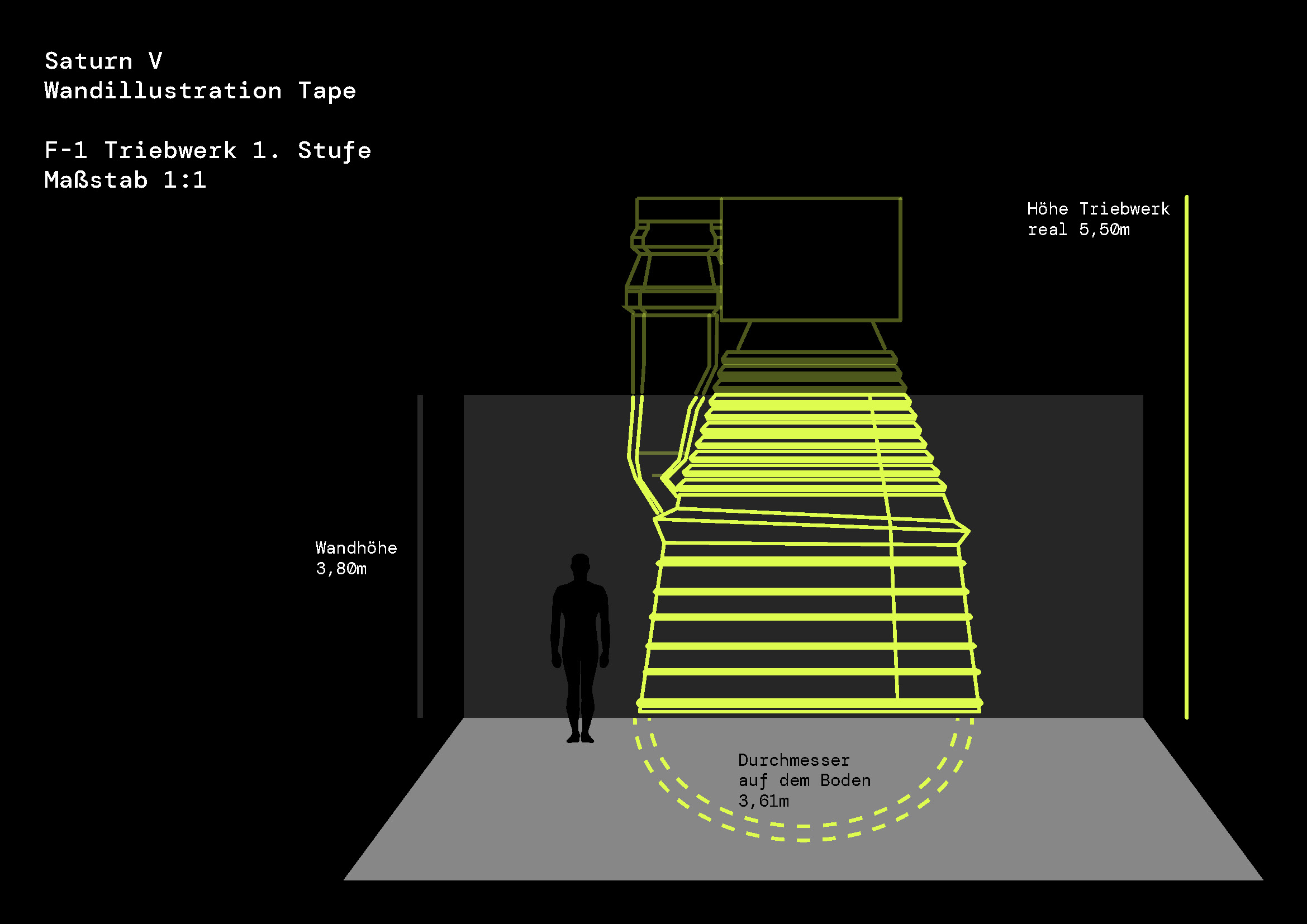

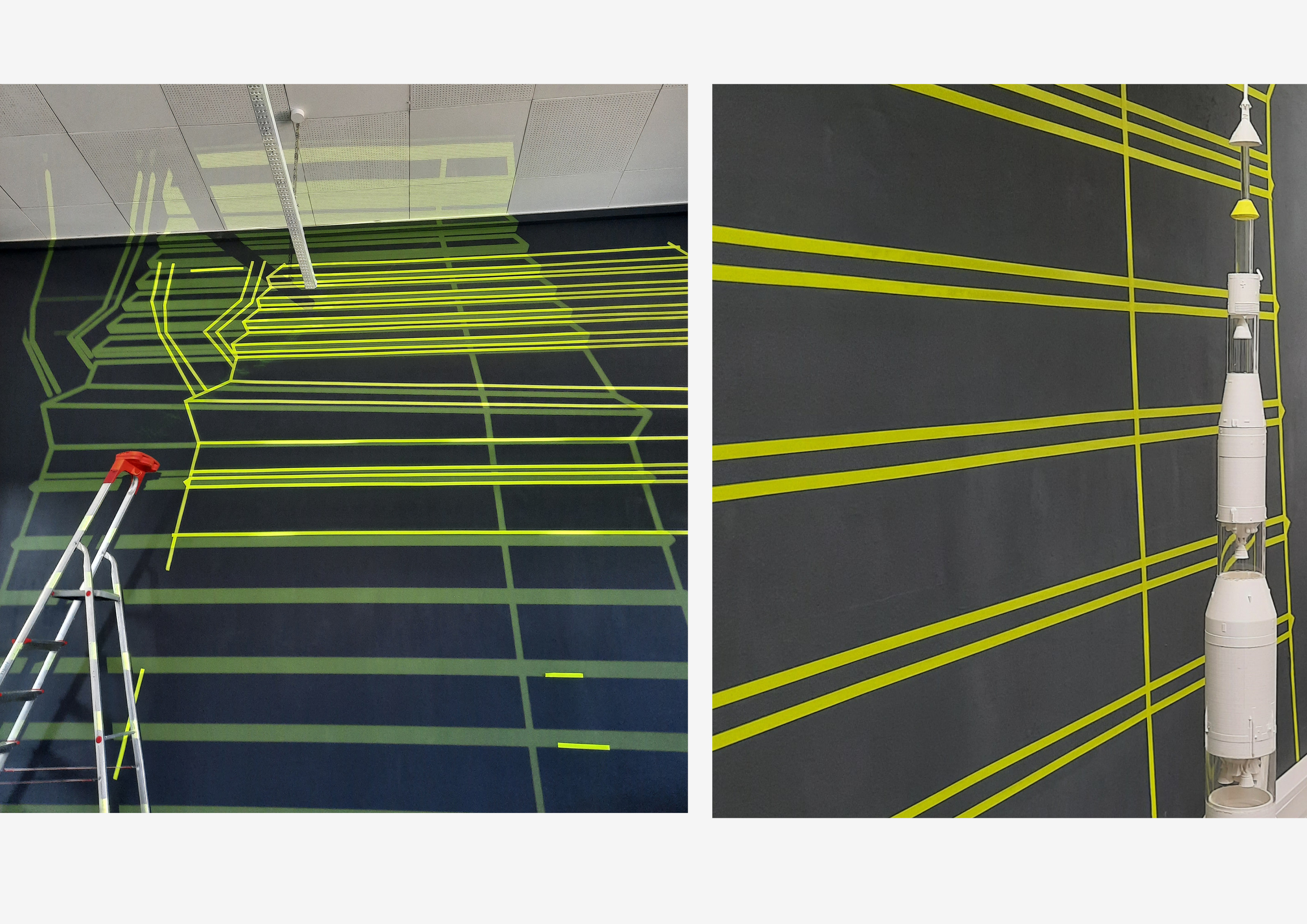
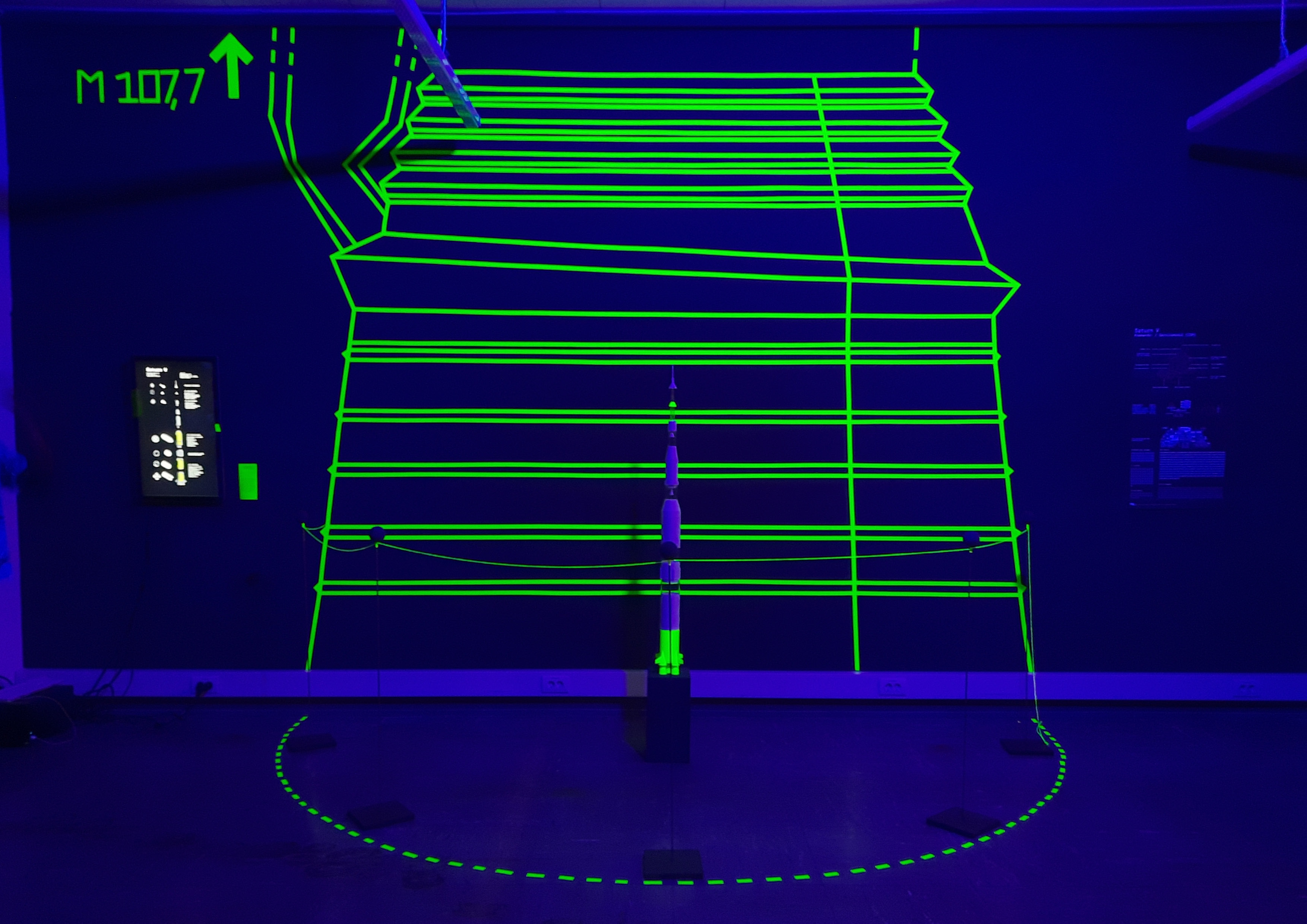
HfG Offenbach Rundgangpreis 2023

Jury Statement
"The award goes to Lea Sophie Krempin and "space rocket - way to the moon". With her work she picks us up on a high level and shows in detail how complex (and big) the challenges of the future of space travel are. 3, 2, 1, let's go!"